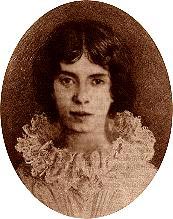|

|
Letters from Emily Dickinson: Responding to Emily Dickinson: Poetic Analysis
Introduction:
In this lesson, students will explore Dickinson’s poem “Safe in
their Alabaster Chambers” both as it was published as well as how it developed
through Dickinson’s correspondence with her sister-in-law Susan Huntington
Gilbert Dickinson. The Dickinsons’ letter manuscripts provide a fascinating
insight into the process of Emily Dickinson’s craft, while simultaneously
complicating commonly held notions that she was a recluse who wrote purely in
isolation. Dickinson in reality maintained many dynamic correspondences throughout
her lifetime and specifically sought out dialogues on her poetry. These correspondences—both
professional and private—reveal a poet keenly aware of the interdependent
relationship between poet and reader.
For a complete introduction to the three lessons in this curriculum unit, Letters
from Emily Dickinson: "Will you be my preceptor?" review the curriculum
unit overview.
Guiding Question:
- How does Emily Dickinson develop her voice as a poet, especially as reflected
in her correspondences with Susan Huntington Gilbert Dickinson about the poem
“Safe in their Alabaster Chambers”?
Learning Objectives:
After completing this lesson, students will be able to
- Recognize Emily Dickinson's poetic style
- Articulate Dickinson’s artistic development as reflected in her poetry
and correspondence
- Discuss Susan Huntington Gilbert Dickinson’s editorial relationship
with Emily Dickinson
- Explore the variants of Dickinson’s poem “Safe in their Alabaster
Chambers”
- Reflect upon the concept of artistic persona
Preparing to Teach this Lesson:
Review the curriculum
unit overview and the lesson plan. Locate and bookmark suggested materials
and other useful websites. If necessary, download and print out any other documents
you will use and duplicate copies as necessary for student viewing.
Activities:
- As a class, read through the first stanza of "Safe in their Alabaster Chambers"
(216), available at the Dickinson Electronic Archives as it appeared
in the Springfield Daily Republican in 1862, and at the American
Verse Project as it was published in 1891 (students will compare these
to the manuscript version shortly). Have your students look closely at the
poem and consider the choices Dickinson makes. Jot down the students' observations
on word usage, imagery, rhythm, etc. They should note her use of architectural
terms, such as "chambers," "rafter," "roof," and her references to building
materials, like "alabaster," satin," "stone." They might also note a feeling
of quiet, with such words as "safe," "untouched," "sleep," and the pause that
results from the repetition of "untouched." Then, there's the absence of "Morning"
and "Noon," which suggests that whatever Dickinson is speaking of must be
"untouched" by the sun. Ultimately, your students should recognize that Dickinson
is writing about tombs.
- Next, guide the students in a discussion of how this poem reflects Dickinson's
voice: Does the poem match the image Dickinson draws of herself in her letters
(see Lesson
One)? For example, do you believe the poem expresses exactly how Dickinson
felt when she viewed the tombs? Why, or why not? What freedom does poetry
give her here that prose would not?
- Now, if you have access to a computer lab, direct the students to the "Emily
Dickinson Writing a Poem" site, which will illustrate how Dickinson sought
critique of her work and used such critique in the process of revision. Working
in pairs, have the students spend about 20 minutes reading through the collected
letters and manuscripts, focusing primarily on the manuscripts H
B74a, H B74b,
H
B74c, H
11c, and H
203c d, (note: all links lead to the manuscript copy accompanied by a
transcript). If students do not have access to computers, provide them with
printouts of the relevant manuscript pages.
- Ask the students if Sue's input helped Dickinson to maintain her voice and
achieve her goals. You may want to guide them to the line that reads, "I am
not suited dear Emily with the second verse - It is remarkable as the chain
lightening that blinds us hot nights in the Southern sky but it does not go
with the ghostly shimmer of the first verse as well as the other one."
Assessment
- Finally, as means of emphasizing the possible positive and negative effects
of editors, refer the students again to the manuscript versions of "Safe in
their Alabaster Chambers," available at the "Emily
Dickinson Writing a Poem" site, and to a version of the poem as edited
by Higginson, available on the EDSITEment reviewed American
Verse Project website. Together as a class, discuss the following question:
How does Higginson's editing change the way you read the poem?
- Redirect the students to the various versions of the second stanza of the
poem (in, H
B74a, H
B74c, H
11c, and H
203c, d.) Still working with their partners, ask the students to decide,
in their opinion, which second stanza is most effective. Have each student compose
a letter to Dickinson explaining their choice. The letter should address Emily's
own desires for her poetry (as expressed in her letters) and describe the
effectiveness of the stanza's language, images, and rhythm in meeting that
desire.
If teaching the entire curriculum unit, teachers should ask students to submit all work in the form of a final portfolio, which may be evaluated based on the overarching curriculum unit assessment rubric.
Selected EDSITEment Websites
- Dickinson Electronic
Archives
[http://jefferson.village.virginia.edu/dickinson/]
- Emily
Dickinson Writing a Poem
[http://jefferson.village.virginia.edu/dickinson/safe/] Features letters
and manuscripts (as original images and in transcription) by Emily Dickinson
and her sister-in-law Susan Huntington Gilbert Dickinson, with explanatory
notes.
- American Verse Project
[http://www.hti.umich.edu/a/amverse/] to be used for the edited text of Dickinson's
poems.
Standards Alignment
View your state’s standards
|





